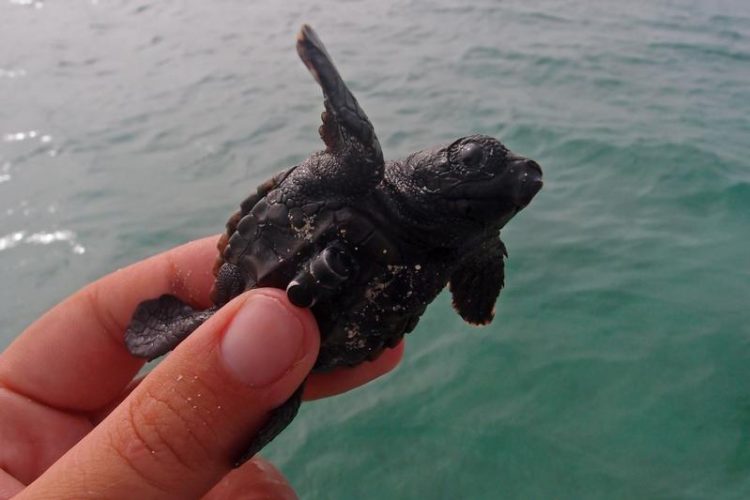Sea turtles’ first days of life: A sprint and a ride towards safety

Turtle hatchling with nano-tag. Photo: Rebecca Scott, GEOMAR
With new nano-sized acoustic transmitters, scientists from GEOMAR Helmholtz Centre for Ocean Research Kiel, the Turtle Foundation and Queen Mary University of London were able to follow the pathways of loggerhead turtle hatchlings from Cape Verde.
The tiny animals quickly swim through predator-rich coastal waters and are then dispersed by nearby ocean currents. According to the study, which was primarily funded by the Kiel Cluster of Excellence “The Future Ocean”, the local oceanic conditions are believed to drive the evolution of some unique swimming behaviours. The results are published in the current issue of the Proceedings of the Royal Society B.
Loggerhead turtles (Caretta caretta) from Cape Verde start their lives with a swimming sprint and a ride on favourable ocean currents. In this way, they escape quickly from predator-rich coastal areas and make their way to the safer open ocean where they spend several years feeding and growing. In this study, tiny acoustic transmitters provided direct insight into these pathways for the first time.
“Thanks to the new technology we can start to fill in key information gaps about the so-called ‘lost years’ Dr. Rebecca Scott states. Funded by the Kiel Cluster of Excellence “The Future Ocean”, the marine biologist coordinated a joint study of GEOMAR Helmholtz Centre for Ocean Research Kiel, the Turtle Foundation and the School of Biological and Chemical Sciences and Dr. Christophe Eizaguirre at the Queen Mary University of London.
“Scientists call this early life phase the ‘lost years’, because they were not able to follow new-born sea turtle hatchlings very far. Hatchlings essentially disappear into the sea until many years later when the lucky survivors return to where they born to breed. But with new techniques like nano-tags and ocean models we are able to see where the tiny young animals go. This is important because the dispersal experiences of hatchlings drive the development of their behaviours into adulthood. The more we understand about the biological and physical determinants of their dispersal and swimming behaviours, the easier we can protect this endangered species.”
In cooperation with the Turtle Foundation at Boa Vista, Cape Verde, the scientists collected hatchlings from two beaches in the northwest and southern tip of the island. Acoustic transmitters with a five millimetres wide and twelve millimetres long streamlined shape that weigh 0,4 grams in water were glued onto the shell of eleven hatchlings. The turtles were then followed at sea using a boat and acoustic receiver for up to eight hours and 15 kilometres. In addition, the swimming behaviour of 16 hatchlings were monitored in “hatchling swimming pools” for several days using data loggers made by engineers at GEOMAR. The turtles swam continuously during their first 24 hours after hatching and then switched to a pattern of activity at daytime and inactivity at night.
Due to the close proximity of offshore currents in this region, it seems the Cape Verdean hatchlings can sleep more at night than hatchlings from other places. For example in America, different research groups have shown that they would have swim a lot more to reach offshore currents”, Dr. Scott explains. “Deep oceanic water and favourable currents, which then determined the travel directions and speeds of our Cape Verdean turtles are situated very near to their nests. Therefore, it is very beneficial for turtles if local oceanic conditions drive the evolution of swimming behaviours that are unique to different nesting locations to ensure their best survival outcomes. It seems that turtles are born with these unique locally adapted behaviours.”
Finally, because larger animals kept swimming for a longer time than smaller individuals, a larger body size is thought to be a good sign of fitness. “But there is some evidence emerging that higher nest temperatures may reduce the size of hatchlings. Therefore, it might be possible that global warming decreases the fitness of the sea turtles by threatening them in more subtle ways than just obvious dangers like the loss of nesting beaches”, Dr. Scott assumes.
Original publication:
Scott, R., Biastoch, A., Roder, C., Stiebens, V. A. and Eizaguirre, C., 2014: Nano-tags for neonates and ocean-mediated swimming behaviours linked to rapid dispersal of hatchling sea turtles. Proc. R. Soc. B., 218, 20141209, doi:10.1098/rspb.2014.1209
Links:
Cluster of Excellence “The Future Ocean”
Turtle Foundation
The School of Biological and Chemical Sciences at the Queen Mary University of London
Contact:
Rebecca Scott (GEOMAR, FB3-EV), Tel.: +49 431 600-4569, rscott@geomar.de
Maike Nicolai (GEOMAR Communication & Media) Tel.: +49 431 600-2807, mnicolai@geomar.de
Media Contact
All latest news from the category: Life Sciences and Chemistry
Articles and reports from the Life Sciences and chemistry area deal with applied and basic research into modern biology, chemistry and human medicine.
Valuable information can be found on a range of life sciences fields including bacteriology, biochemistry, bionics, bioinformatics, biophysics, biotechnology, genetics, geobotany, human biology, marine biology, microbiology, molecular biology, cellular biology, zoology, bioinorganic chemistry, microchemistry and environmental chemistry.
Newest articles

Superradiant atoms could push the boundaries of how precisely time can be measured
Superradiant atoms can help us measure time more precisely than ever. In a new study, researchers from the University of Copenhagen present a new method for measuring the time interval,…

Ion thermoelectric conversion devices for near room temperature
The electrode sheet of the thermoelectric device consists of ionic hydrogel, which is sandwiched between the electrodes to form, and the Prussian blue on the electrode undergoes a redox reaction…

Zap Energy achieves 37-million-degree temperatures in a compact device
New publication reports record electron temperatures for a small-scale, sheared-flow-stabilized Z-pinch fusion device. In the nine decades since humans first produced fusion reactions, only a few fusion technologies have demonstrated…





















